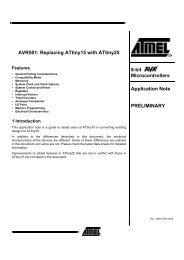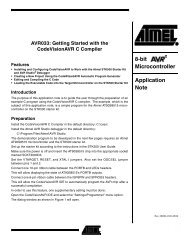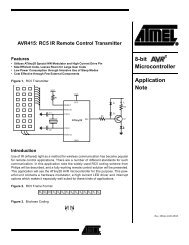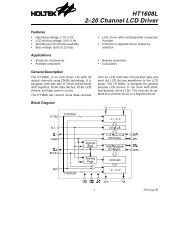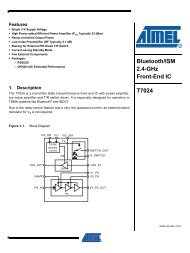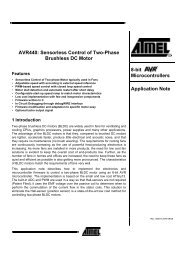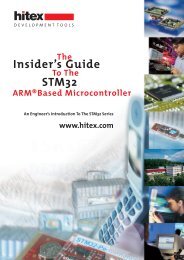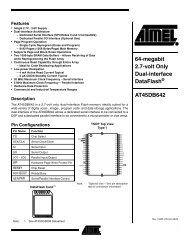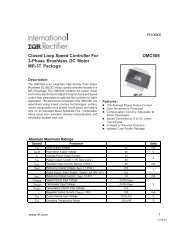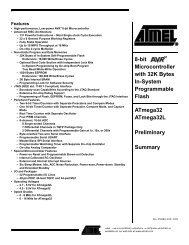Preliminary C8051F120/1/2/3 C8051F124/5/6/7 - KEMT FEI TUKE
Preliminary C8051F120/1/2/3 C8051F124/5/6/7 - KEMT FEI TUKE
Preliminary C8051F120/1/2/3 C8051F124/5/6/7 - KEMT FEI TUKE
Create successful ePaper yourself
Turn your PDF publications into a flip-book with our unique Google optimized e-Paper software.
<strong>C8051F120</strong>/1/2/3<br />
<strong>C8051F124</strong>/5/6/7<br />
<strong>Preliminary</strong><br />
The FLASH Access Limit security feature (see Figure 15.2) protects proprietary program code and data from being<br />
read by software running on the <strong>C8051F120</strong>/1/2/3/4/5/6/7. This feature provides support for OEMs that wish to program<br />
the MCU with proprietary value-added firmware before distribution. The value-added firmware can be protected<br />
while allowing additional code to be programmed in remaining program memory space later.<br />
The Software Read Limit (SRL) is a 17-bit address that establishes two logical partitions in the program memory<br />
space. The first is an upper partition consisting of all the program memory locations at or above the SRL address, and<br />
the second is a lower partition consisting of all the program memory locations starting at 0x00000 up to (but excluding)<br />
the SRL address. Software in the upper partition can execute code in the lower partition, but is prohibited from<br />
reading locations in the lower partition using the MOVC instruction. (Executing a MOVC instruction from the upper<br />
partition with a source address in the lower partition will return indeterminate data.) Software running in the lower<br />
partition can access locations in both the upper and lower partition without restriction.<br />
The Value-added firmware should be placed in the lower partition. On reset, control is passed to the value-added<br />
firmware via the reset vector. Once the value-added firmware completes its initial execution, it branches to a predetermined<br />
location in the upper partition. If entry points are published, software running in the upper partition may execute<br />
program code in the lower partition, but it cannot read or change the contents of the lower partition. Parameters<br />
may be passed to the program code running in the lower partition either through the typical method of placing them<br />
on the stack or in registers before the call or by placing them in prescribed memory locations in the upper partition.<br />
The SRL address is specified using the contents of the FLASH Access Register. The 8 MSBs of the 17-bit SRL<br />
address are determined by the setting of the FLACL register. Thus, the SRL can be located on 512-byte boundaries<br />
anywhere in program memory space. However, the 1024-byte erase sector size essentially requires that a 1024<br />
boundary be used. The contents of a non-initialized FLACL security byte are 0x00, thereby setting the SRL address<br />
to 0x00000 and allowing read access to all locations in program memory space by default.<br />
Figure 15.3. FLACL: FLASH Access Limit<br />
R/W R/W R/W R/W R/W R/W R/W R/W Reset Value<br />
00000000<br />
Bit7 Bit6 Bit5 Bit4 Bit3 Bit2 Bit1 Bit0 SFR Address:<br />
SFR Address: 0xB7<br />
SFR Page: F<br />
Bits 7-0:<br />
FLACL: FLASH Access Limit.<br />
This register holds the most significant 8 bits of the 17-bit program memory read/write/erase limit<br />
address. The lower 9 bits of the read/write/erase limit are always set to 0. A write to this register sets<br />
the FLASH Access Limit. This register can only be written once after any reset. Any subsequent<br />
writes are ignored until the next reset. To fully protect all addresses below this limit, bit 0 of FLACL<br />
should be set to ‘0’.<br />
Page 178<br />
DS008-0.8-AUG02 © 2002 Cygnal Integrated Products, Inc.



